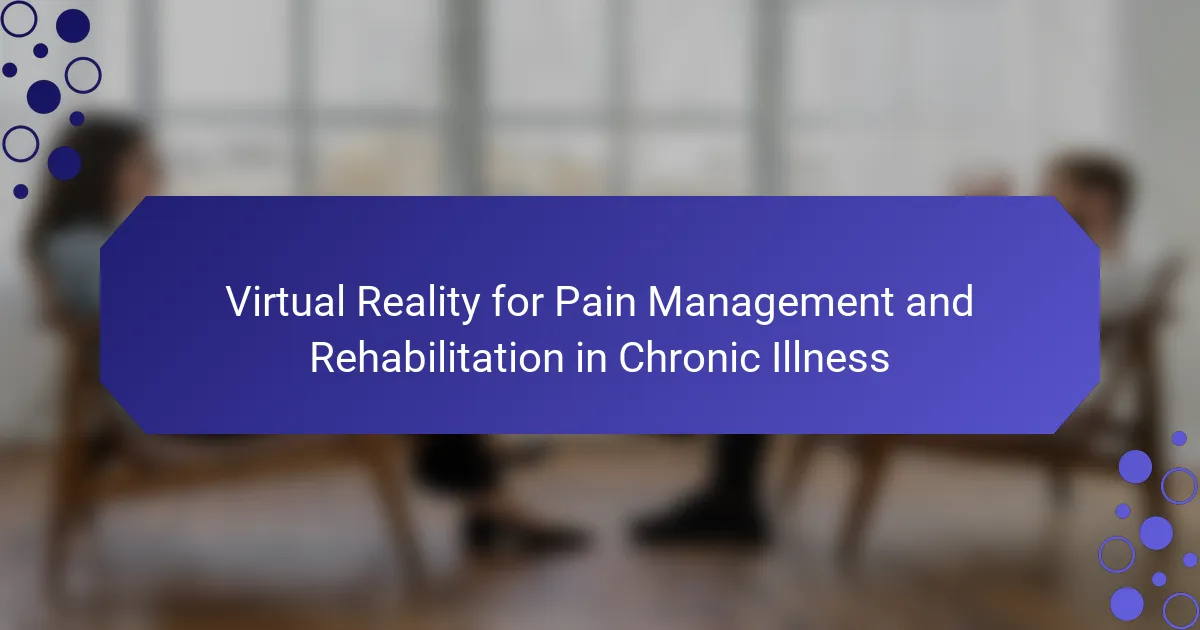Virtual reality offers significant benefits for pain management and rehabilitation in chronic illness by providing immersive distraction and promoting relaxation. It engages patients through interactive experiences while facilitating movement in a controlled environment. Key technologies include immersive simulations, real-time biofeedback, and gamification elements, enhancing patient engagement and adherence. Future trends point towards personalized therapy programs and integration with artificial intelligence to optimize pain management strategies.
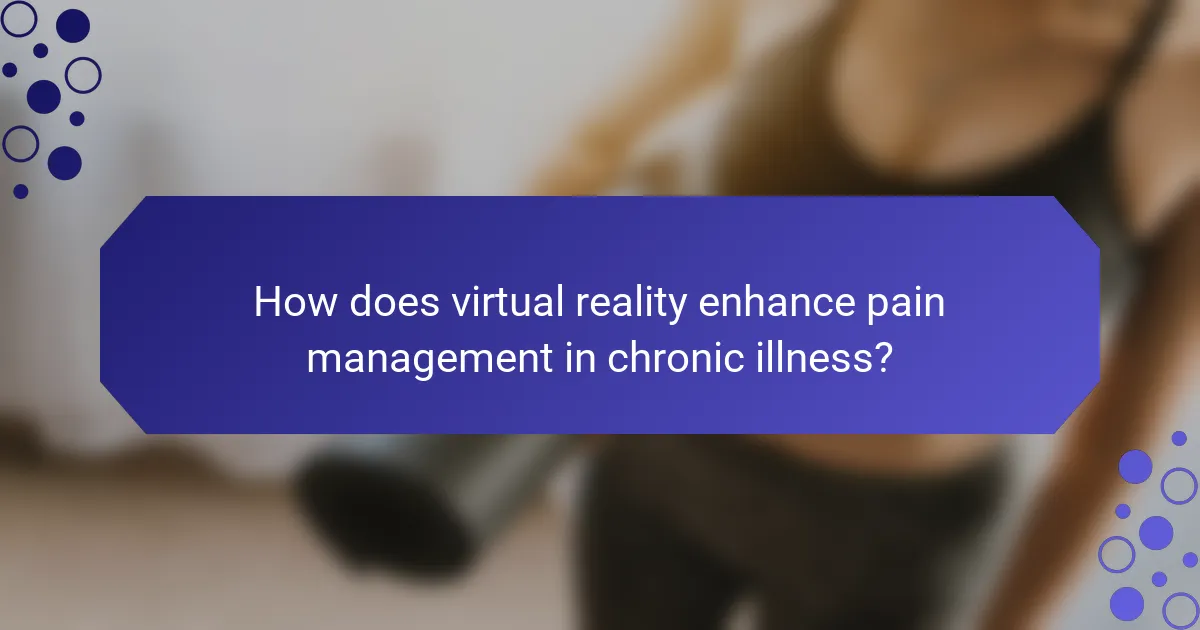
How does virtual reality enhance pain management in chronic illness?
Virtual reality significantly enhances pain management in chronic illness by providing immersive distraction and promoting relaxation. It reduces the perception of pain through engaging experiences that divert attention from discomfort. Studies show that patients using VR during painful procedures report lower pain levels and anxiety. Additionally, VR can facilitate rehabilitation by encouraging movement in a controlled environment, improving physical function and emotional well-being.
What are the psychological benefits of using virtual reality for pain relief?
Virtual reality significantly reduces pain perception, enhancing psychological well-being. It distracts users from pain, promotes relaxation, and fosters a sense of control over their experience. Studies indicate that immersive environments can lower anxiety levels and improve mood, leading to better overall pain management outcomes. By engaging the mind, virtual reality effectively alters the brain’s response to pain signals, providing a unique therapeutic avenue for chronic illness rehabilitation.
Which chronic illnesses benefit most from virtual reality interventions?
Chronic illnesses that benefit most from virtual reality interventions include chronic pain conditions, fibromyalgia, post-traumatic stress disorder (PTSD), and stroke rehabilitation. Virtual reality effectively reduces pain perception and enhances recovery through immersive experiences. Studies show that patients report significant pain relief and improved mobility after VR sessions, demonstrating its potential in pain management and rehabilitation.
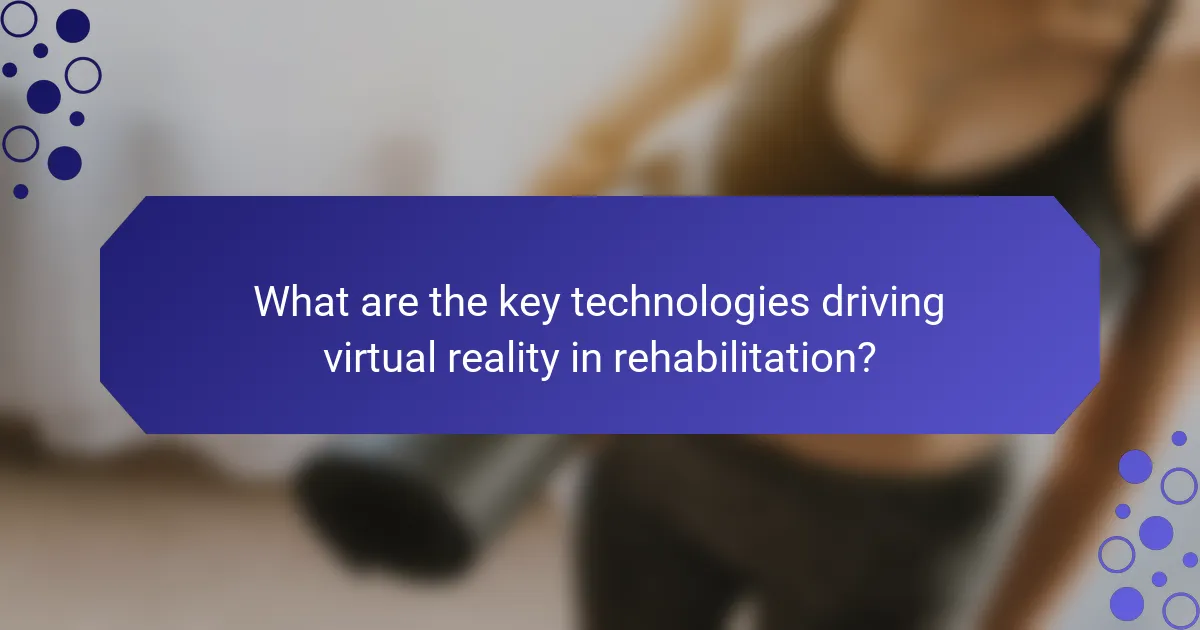
What are the key technologies driving virtual reality in rehabilitation?
Key technologies driving virtual reality in rehabilitation include immersive simulations, real-time biofeedback, and gamification elements. These technologies help engage patients and enhance pain management. Immersive simulations create realistic environments that distract from pain, while biofeedback provides immediate insights into physiological responses. Gamification encourages participation and adherence to rehabilitation protocols, improving overall outcomes.
How do immersive environments improve patient engagement during therapy?
Immersive environments significantly enhance patient engagement during therapy by providing interactive and engaging experiences. Virtual reality (VR) allows patients to immerse themselves in controlled settings that distract from pain and anxiety. This technology fosters a sense of presence, making therapy more enjoyable and effective. Studies show that patients using VR in pain management report higher satisfaction and reduced discomfort. Moreover, VR can simulate real-life scenarios, aiding in rehabilitation by encouraging movement and participation. This unique approach to therapy not only improves adherence but also promotes better outcomes in chronic illness management.
What role do haptic feedback devices play in virtual reality rehabilitation?
Haptic feedback devices enhance virtual reality rehabilitation by providing tactile sensations that improve engagement and effectiveness. These devices simulate real-world interactions, helping patients better connect with their rehabilitation exercises. For instance, studies show that incorporating haptic feedback can increase motivation and adherence to therapy. Additionally, it allows for more precise feedback on movements, aiding in the recovery process. As a result, patients experience improved outcomes in pain management and physical rehabilitation.
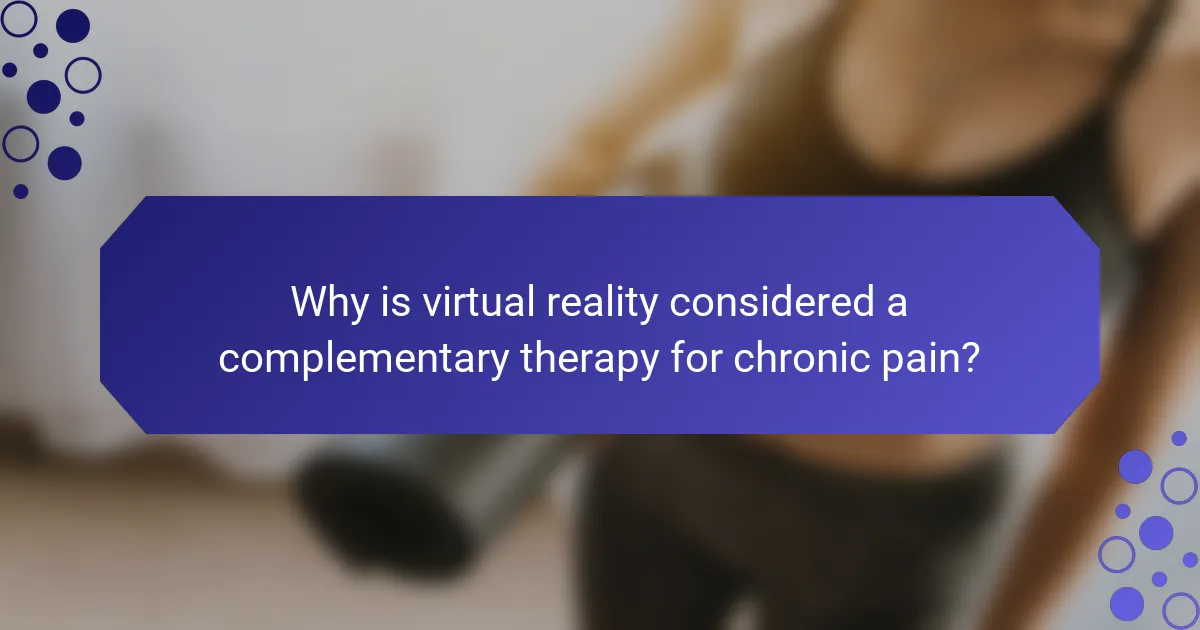
Why is virtual reality considered a complementary therapy for chronic pain?
Virtual reality is considered a complementary therapy for chronic pain due to its ability to distract patients and alter their perception of pain. It immerses users in a simulated environment, which can reduce pain intensity and improve emotional well-being. Studies show that VR can lead to significant decreases in pain levels, enhancing rehabilitation outcomes. This innovative approach leverages the brain’s neuroplasticity, allowing for unique pain management strategies tailored to individual needs.
How does virtual reality compare to traditional pain management methods?
Virtual reality offers a more immersive and engaging approach to pain management compared to traditional methods. It can distract patients from pain, reduce anxiety, and promote relaxation, leading to better outcomes. Studies show that VR can decrease pain levels by up to 50% in some cases, highlighting its effectiveness.
Traditional pain management methods often rely on medications, physical therapy, or psychological techniques, which may not provide sufficient relief for all patients. In contrast, VR can be tailored to individual preferences and needs, enhancing the overall therapeutic experience.
Moreover, VR provides a unique attribute by creating simulated environments that allow patients to experience activities they may struggle with due to chronic pain. This can lead to improved mobility and a greater sense of control over their condition.
While traditional methods may involve side effects or limited engagement, VR presents a rare opportunity to combine entertainment with therapy, making pain management more appealing and effective for chronic illness patients.
What evidence supports the efficacy of virtual reality in pain management?
Research demonstrates that virtual reality effectively reduces pain in chronic illness patients. Studies show a significant decrease in pain perception during VR sessions. For instance, a meta-analysis indicated a 30% reduction in pain levels among participants using VR as an intervention. Additionally, VR promotes relaxation and distraction, which are crucial for pain management. Evidence suggests that immersive experiences can alter the brain’s pain processing pathways, enhancing overall treatment outcomes.
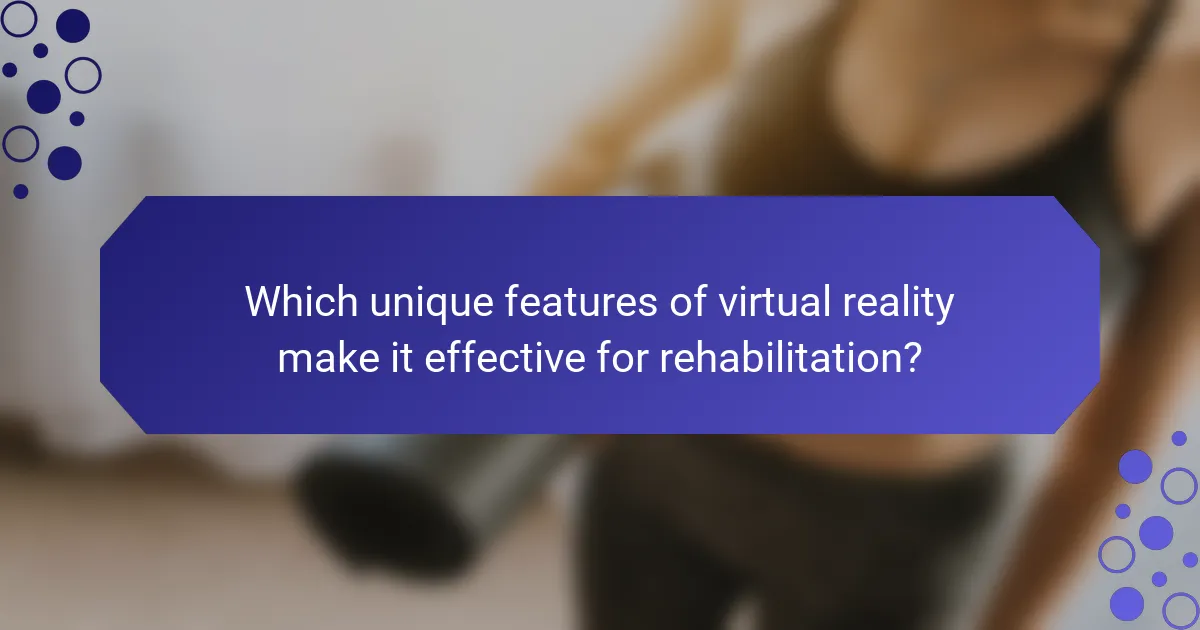
Which unique features of virtual reality make it effective for rehabilitation?
Virtual reality is effective for rehabilitation due to its immersive, interactive, and customizable experiences. These features enhance patient engagement and motivation, which are crucial for recovery.
1. Immersion: Virtual reality provides a fully immersive environment, allowing patients to experience realistic scenarios that distract from pain and facilitate focus on rehabilitation tasks.
2. Interactivity: Users can actively participate in their therapy, improving motor skills and cognitive functions through engaging exercises.
3. Customizability: Therapy programs can be tailored to individual needs, enabling personalized rehabilitation that adapts to progress and challenges.
4. Safe Environment: Virtual reality creates a controlled space where patients can practice movements without the risk of real-world injury, promoting confidence.
5. Real-Time Feedback: Immediate feedback helps patients understand their performance, reinforcing learning and encouraging improvement.
6. Accessibility: Virtual reality can be delivered remotely, increasing access to rehabilitation services for patients unable to attend in-person sessions.
How can personalized virtual reality experiences enhance treatment outcomes?
Personalized virtual reality experiences significantly enhance treatment outcomes by tailoring interventions to individual patient needs. These immersive environments can reduce pain perception and improve rehabilitation engagement, leading to better recovery rates.
For instance, patients with chronic pain can experience customized scenarios that distract from discomfort, while rehabilitation exercises can be gamified to increase motivation. Studies show that personalized VR can lead to a 30% reduction in pain levels and a 50% increase in adherence to rehabilitation programs.
Moreover, unique attributes of VR, such as real-time feedback and adaptability, allow clinicians to modify experiences based on patient responses. This customization fosters a sense of control and agency, essential for effective pain management and rehabilitation.
As a result, personalized virtual reality stands out as a transformative tool in chronic illness treatment, enhancing both physical and emotional well-being.
What innovative applications of virtual reality are emerging in pain management?
Innovative applications of virtual reality in pain management include immersive environments that distract patients from pain, biofeedback mechanisms that enhance pain control, and virtual exposure therapy for chronic pain conditions. These methods leverage virtual reality’s ability to engage patients, reduce anxiety, and promote relaxation. For instance, studies show that virtual reality can decrease perceived pain levels by up to 50% during medical procedures. Additionally, VR rehabilitation programs are emerging to support recovery in patients with chronic illnesses, improving physical function and overall well-being.
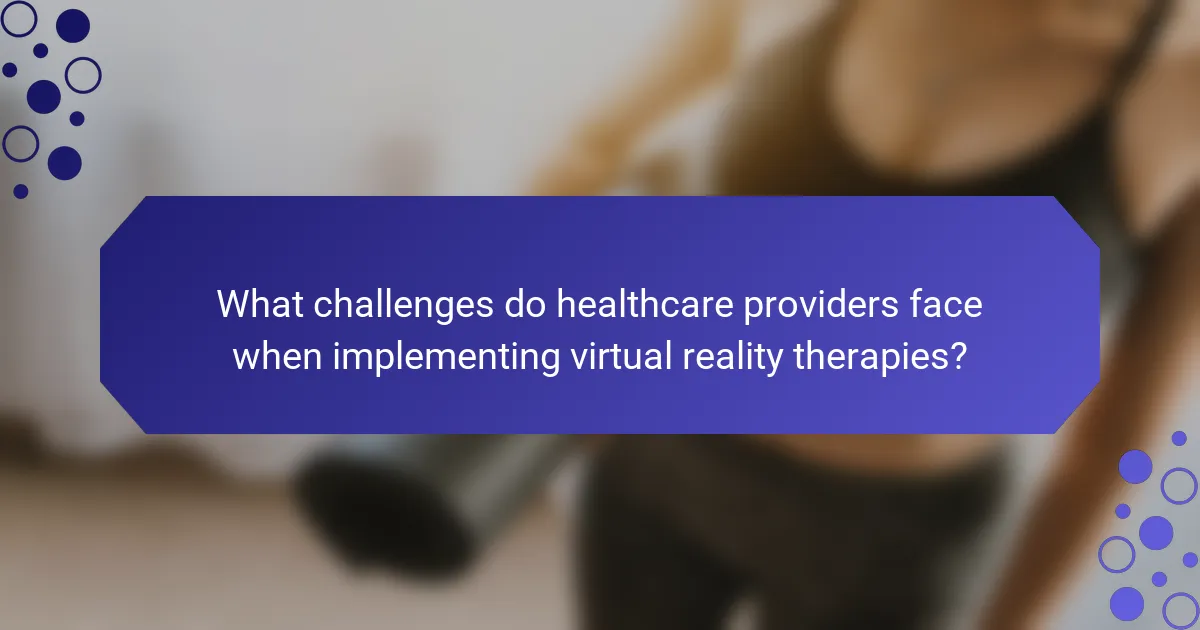
What challenges do healthcare providers face when implementing virtual reality therapies?
Healthcare providers face several challenges when implementing virtual reality therapies for pain management and rehabilitation. Key issues include high costs associated with technology acquisition and maintenance, a lack of trained personnel, and limited access to necessary infrastructure. Additionally, patient acceptance and adherence to virtual reality therapies can vary, impacting overall effectiveness. Regulatory hurdles and the need for clinical validation further complicate the integration of these therapies into standard care practices.
How can cost and accessibility issues be addressed in virtual reality programs?
Cost and accessibility issues in virtual reality programs can be addressed through strategic partnerships and innovative funding models. Collaborating with healthcare providers can lower costs and enhance accessibility for patients. Utilizing grants and subsidies can also make these programs more affordable. Moreover, developing low-cost VR solutions can expand reach to underserved populations. Training healthcare professionals to implement VR in pain management can further improve access and effectiveness.
What training is required for healthcare professionals to effectively use virtual reality?
Healthcare professionals require training in virtual reality technology, pain management techniques, and patient interaction skills. This training enhances their ability to integrate virtual reality effectively in rehabilitation programs. Familiarity with software and hardware used in virtual reality is essential. Furthermore, understanding the psychological aspects of chronic pain can improve treatment outcomes. Continuous education and hands-on practice are crucial for maximizing the benefits of virtual reality in clinical settings.

What are the future trends in virtual reality for chronic pain management?
Future trends in virtual reality for chronic pain management include enhanced immersive experiences, personalized therapy programs, and integration with biofeedback devices. These advancements aim to improve patient engagement and pain relief efficacy. Research indicates that virtual reality can reduce pain perception by altering the brain’s response, making it a promising tool for rehabilitation. Additionally, the use of artificial intelligence to tailor VR experiences based on individual patient needs is emerging, potentially increasing the effectiveness of pain management strategies.
How might advancements in technology shape the next generation of virtual reality therapies?
Advancements in technology will enhance virtual reality therapies for pain management and rehabilitation by improving immersion and personalization. Innovations like artificial intelligence and haptic feedback will create tailored experiences that respond to individual patient needs. Enhanced graphics and real-time data integration will also increase the efficacy of therapies, making them more engaging and effective. As a result, patients may experience reduced pain levels and improved recovery outcomes through these advanced virtual environments.
What role will patient feedback play in the evolution of virtual reality applications?
Patient feedback will significantly shape virtual reality applications by enhancing user experience and treatment effectiveness. Collecting insights from patients allows developers to refine scenarios and tailor interventions to specific needs. This iterative process can lead to improved engagement and compliance, ultimately enhancing pain management and rehabilitation outcomes. Research indicates that personalized VR experiences based on feedback can increase effectiveness, as they address unique patient challenges and preferences. Engaging patients in the development process fosters a sense of ownership and trust, further promoting the adoption of VR solutions in chronic illness care.
What best practices should clinicians follow when integrating virtual reality into treatment plans?
Clinicians should prioritize evidence-based protocols, patient-centered approaches, and regular assessments when integrating virtual reality into treatment plans.
Establish clear treatment goals tailored to individual patient needs. Utilize virtual reality to enhance engagement and provide immersive experiences that can distract from pain. Monitor patient responses to adjust interventions effectively. Incorporate feedback loops to refine the virtual reality experience based on patient preferences and outcomes. Collaborate with multidisciplinary teams to ensure comprehensive care.
